One of the branches of the art of crocheting is Irish lace. You can often see various details in the form of flowers, leaves and others connected by a bizarre network. Patterns of motifs with descriptions can be found for every taste and try to create a unique thing yourself.
Where to start learning to knit Irish lace
Irish lace is one of the most common types of needlework. Using a hook and a pattern with a description of the motifs, you can create a unique pattern and weave it, creating a sweater, napkin or shawl.
The technique involves knitting individual elements, which are then laid out on a pattern and connected with a lattice. Weaving requires attention and perseverance, like any other handicraft, this is especially important for beginners.
For those who are just about to work in the Irish lace technique, the following tips will be useful:
- To begin with, it is worth learning the basics of crocheting - air loops, columns;
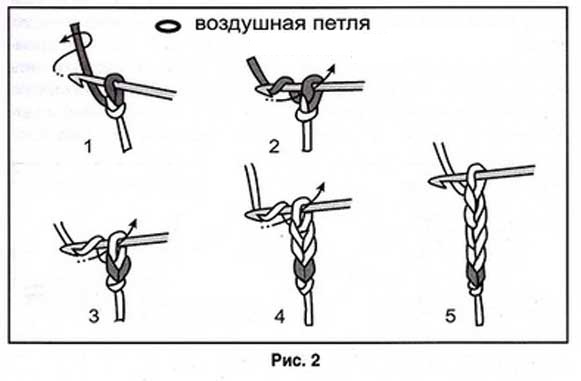
- when knitting, it is important to consider the thickness of the thread - the future work depends on it;
- It is best to start with the simplest schemes, and thus get the hang of it;
- it is worth thinking in advance about the method of joining the lace parts based on what kind of thing you want to get in the end;
- at first, you can use ready-made napkins or hats and decorate them with your own knitted product (for example, a flower);
- a combination of yarns of different thicknesses can give the future item a more interesting look (for example, thin for the net, and thick for the details);
- You need to practice as often as possible in order to eventually be able to knit the most complex works, such as, for example, dresses.
Working in Irish lace technique requires precise execution of the pattern according to the scheme. It may happen that one wrong detail will ruin the whole product, and you will have to unravel it and knit it again.
In needlework, there are basic elements that beginners start with, and which are also the most common in knitting:
- leaves;
- leaves with crocheted veins;
- trefoils;
- voluminous flowers with crocheted petals;
- bunches of grapes.
The type of connection that is used in most cases is called a grid. To do this, the connected parts are laid out according to the scheme, and then covered with a grid. Usually, the grid part is created at the very beginning, and only then do they start working on the details.
Sometimes, mesh tulle is used in the work - this method will be more convenient for beginners who are just learning to knit mesh. Such models also look good.
Professionals in lace making first make the elements and only then assemble them into a single structure, tying them with a net. This process is more labor-intensive and time-consuming, but in the end the result is magnificent.
How to read schematics
To start knitting Irish lace, you need patterns. But for beginners it is not always clear how to read them and understand the principle of knitting.
To learn how to understand diagrams, you can use the following tips:
- you can try to draw a picture yourself, using an existing pattern you like as a guide - this way you can understand where the beginning of knitting is;
- Japanese ready-made patterns may be easier to understand, since they indicate the knitting direction;
- There are many master classes on the Internet that clearly explain the principle of reading a particular diagram;
- if there is a ring on the diagram, this is most likely the starting point;
- It is worth trying to start working from different points, in this way you can not only gain experience, but also understand the features of knitting in different ways.
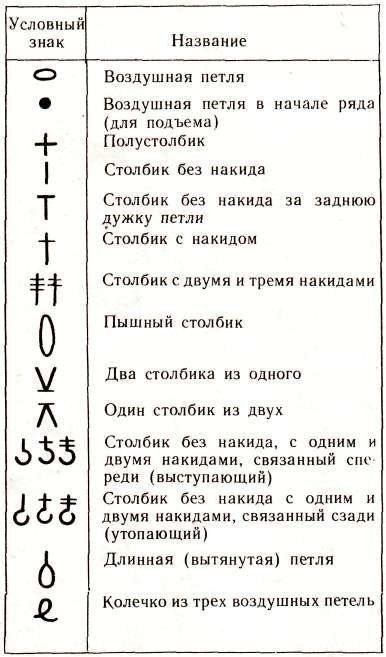
The beginning of work usually occurs with an air loop, which is quite standard. Further in the schemes you can find the already familiar abbreviations of half loops (h/l), double crochets (dc) and single crochets (ss). Further, the success of the future product depends on the correct scheme. This is especially true for self-built ones.
The appearance of the item depends on the correct construction. Also, due to unsuccessful patterns, “tails” may remain during knitting or threads may be knocked out. To avoid the appearance of “tails”, it is recommended to leave the remainder of the yarn at least 8 cm. If it turns out to be more, the hanging thread can then be sewn with an embroidery needle.
Simple Irish Lace Elements for Beginners
Irish lace, patterns of motifs with descriptions of which can be found on the Internet, implies both the creation of a complex pattern and a simple uniform one, intended just for beginners. Images of the future product are usually not complex, used only to copy a liked pattern or recreate a previously seen work.
The details can be connected both in a strict and in a random order. Beginners in lace work are best to start with detailed master classes, where knitting of simple elements is explained. The most popular are: butterflies, leaves and flowers.
For knitting you only need a hook, sometimes you may need white thread.
Irish Lace Joining for Beginners
Beginners can use ready-made mesh tulle at the stage of joining the fragments – it is enough to simply attach the lace details. Creating the net yourself is a rather labor-intensive process that requires attention and perseverance. You should be prepared for the fact that at first the weaving will not be successful.
There are 5 types of networks for connecting parts. All of them are based on the fact that to start working, you need to correctly lay out the elements, according to the pattern (if it is clothing) or diagram.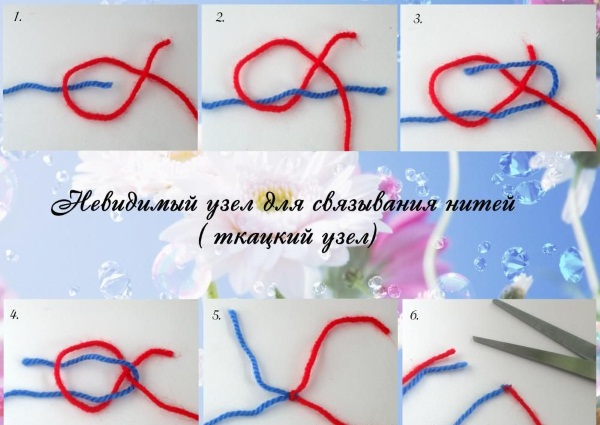
- Connecting as elements are created. The network is knitted as fragments appear.
- Arbitrary network. The cells do not have any specific shape, but are knitted in arbitrary geometry. However, it is still worth watching that they are not too large, or, conversely, there is no accumulation of too small ones.
- Attaching elements to a previously purchased or linked network. A method suitable for beginners.
- Using cotton tulle.
- Simple needle stitching. This method is suitable when the elements are uniform and the same size. In this case, you can use this convenient method.
When working on a net, it is important to consider the convenience of the work area. It is advisable to secure the fragments with pins so as not to accidentally brush them off or displace them. If knitted motifs are sewn onto ready-made material, it should also be secured and stretched.
Next, you need to pay attention to the yarn itself. If it is "slippery", it is secured with several stitches at the beginning and finished in the same way. The net is knitted either from left to right, or vice versa, connecting with tightening or columns.
One way to make a column:
- Air loops are collected and the first arch is knitted using them.
- When knitting the next row, the hook is removed from the loop of the previous chain and also inserted into the loop of the previous arch, but already grabbing the working thread, pulling it through and knitting it.
- This type of weaving is stiff and very suitable for working with slippery yarn.
With this method of weaving, the net will not "come apart", as can often be seen with slippery yarn. For cotton threads, the method of "tying" under the arch of the previous row is suitable.
Motive schemes
Irish lace, the patterns of motifs with descriptions of which exist quite a large number, it is still better to start with the simplest. Usually this means non-voluminous and uniform knitting, with a simple pattern.
If at first the color combination of yarn causes difficulties, it is worth taking a single-color one. Incompatible colors spoil the work no less than an incorrectly composed scheme.
Leaflet
For beginners, you can find master classes on knitting leaves online - from the simplest to the most intricate. It is quite easy to knit a small relief leaf.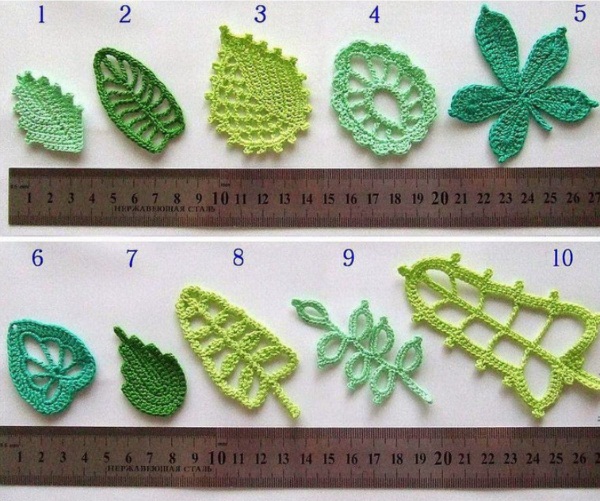
- Cast on 18 air loops (ch). Then make a picot out of 3 loops (picots are ch loops that are secured in the place where they began with a slip stitch), after which 4 double crochets, 2 half crochets and 5 single crochets are knitted.
- Then the leaf is turned over and through 1 ch, s.b. yarn overs are knitted behind the back half loop.
- In this way, a row without a yarn over is knitted for the back loops. It is important not to touch the picot.
- Now in the 2 VP picot, 2 dc yarn overs are knitted behind the back pp of the previous row. The same is knitted 5 more times, each time repeating 2 dc yarn over 2 VP.
- This is how 7 "veins" are knitted on the leaf. The next side of the leaf begins with a picot in a row of single crochets.
- In the opposite direction, 4 double crochets are knitted, 2 half double crochets and until the end – double crochets.
- Without finishing knitting 2 loops at the end, turn the sheet over and knit everything the same way as at the beginning.
The excess threads are removed. The sheet is ready.
Butterfly
Irish lace (patterns of motifs with descriptions include various forms of details) is quite often found with the use of butterflies as an element. There are voluminous and complex butterflies, but you can also find easier patterns designed specifically for beginners. In some of them, the motif is knitted only on one side (i.e. "butterfly in profile").
- For the body, cast on 17 ch, then skip 3 loops and knit: 3 double crochets, 1 half crochet, 2 single crochets, 1 half crochet again, 5 dc, 1 half dc, 1 dc. Then knit another 10 ch, and again through 3 loops go 3 dc, 3 ch, 7 sl st. along the chain.
- Along a chain of 17 VP, 16 sts are knitted without yarn over.
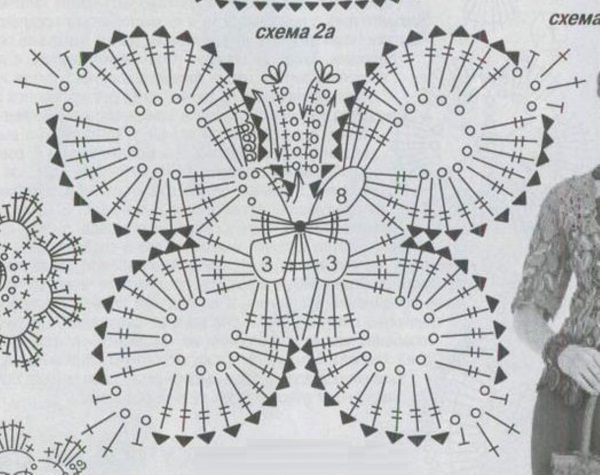
Irish lace. Butterfly motif pattern with description - For the lower wing of the butterfly, 21 ch are cast on, the last loop is held, and immediately 27 more ch are knitted, clasping the chain, 4 dc (on the dc of the last row of the body), 5 ch, 2 dc through 2 dc before the 1st row of the wing.
- Under the arch are knitted 2 dc without yarn over, 6 ch, 2 dc without yarn over, through 2 dc without yarn over. under the arch – 3 dc without yarn over, 6 ch, 2 dc without yarn over, through 2 dc without yarn over. under the arch – 8 dc without yarn over, under the next – 3 dc without yarn over, 5 ch, 2 dc without yarn over, on the tops of the 3rd and 4th dc without yarn over of the front cell. Under the arch of 5 ch are knitted 9 dc without yarn over, under the next – 4 more without yarn over, under the next – 2. On the 2nd and 3rd dc without yarn over of the cell of 5 ch under the arch – 3 dc without yarn over, 6 ch, 2 dc without yarn over. At the top of the 6th and 7th cells of 5 ch - 10 dc, under the next one - 6 dc, under the last one - 3 dc and 3 more at the top of the last row on the body.
- For the upper wing, a chain of 8 ch is made, 1 dc is knitted at the top of the 5th cell of the lower wing. Under the arch of 8 ch, 15 dc without nak are knitted, 4 dc without nak on the last row of the body.
- Another 4 ch are cast on, after 3 dc without yarn over, 2 dc without yarn over are knitted, under the arch - 2 dc without yarn over, 6 ch and 2 dc without yarn over, after 3 dc without yarn over under the arch - 3 dc without yarn over. 6 ch, 2 dc without yarn over, 3 dc without yarn over. Under the arch, 6 ch are knitted, 1 dc without yarn over to the top of the extreme dc without yarn over of the 1st row of the upper wing.
- Under the arch, knit 10 dc without nak, 1 dc without nak. Under the next arch - 4 ch, 2 dc without nak on the tops of the 3rd and 4 dc without nak cells. Under the arch, knit 8 dc without nak, the next - 4 dc without nak. 5 ch, 1 dc without nak on the top of 2 dc without nak cells from 4 ch. 3 dc without nak.
- This step is done twice. Under the arch - 5 ch, 1 st. without nak., through 1 st. of the cell of 4 ch, under the next one knit another 3 st. without nak.
- Under 2 halves of the arches knit 8 dc without yarn, under the last one - 4 dc without yarn, 3 dc without yarn at the tops of the last row of the body, then 5 ch, 2 dc without yarn, on the top 2 and 3 dc without yarn. 2 cells. Under the arch - 3 dc without yarn, 6 ch, 2 dc without yarn at the top of the 4th and 5th next cells, under the arch - 3 more without yarn.
- Next, 3 times, knit arches of 8 ch, and secure 3 and 4 single crochet stitches on top of each subsequent arch, under which 3 single crochet stitches are additionally knitted.
- Under 1 arch, 13 sts without yarn are knitted; under 2 – 9, under 3 – 8, under 4 – 5, under 5 – 4. And lastly, at the top of the extreme sts without yarn of the last row of the body, 1 sts without yarn is knitted.
The butterfly is ready.
Flower
The most common element used in the works of both professionals and beginners.
To knit an 8-petal flower, you need:
- Cast on a chain of 9 air loops (ch). In the 8th (from the hook) knit a dc.
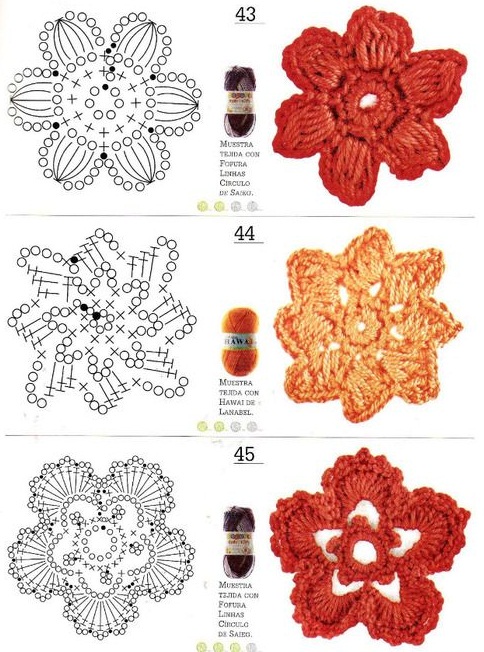
- Then 4 more ch. Dc is knitted into the same loop as 1 dc yarn over. Everything needs to be repeated until 7 dc yarn overs are formed.
- When the last 4 VP are sewn, the 3rd loop of the first chain is grabbed with a hook and a connecting loop is knitted.
- 1 VP on the rise and in all the arches of 4 loops, 5 sts without a yarn are knitted. Everything ends with a connecting loop in VP from the rise.
- Next, a chain of 20 VP is collected. The hook is inserted into the same place from where they were collected and everything is secured with a connection. At this stage, knitting will go in a spiral.
- The right side of the chain is knitted: 4 dc without yarn over, 5 half-dc, 6 dc with 1 yarn over, 2 dc with 2 yarn overs, and a picot of 3 ch. Now the left side is knitted: 2 dc with 2 yarn overs, 6 dc with 1 yarn over, 5 half-dc, 4 dc without yarn over. You have a petal. It is secured at the place where it starts (with a connecting loop).
- Then knitting goes to the left: 4 sl sts without yarn over, 2 rows. In 5 sl sts without yarn over we make another sl st, on it we again collect 20 ch. This will be the second petal.
- The 2nd and subsequent 6 petals are knitted in the same way as the first one. They end with a slip stitch in the middle of 1 petal.
- Along the edge of the petal, 7 slip stitches are knitted. Then, the sl st and ch are repeated until the picot. 5 sl sts are knitted directly into the picot.
- At the time of tying, you need to move to the adjacent petal using a connecting loop.
- In this way, all the remaining petals are connected.
Finish knitting by carefully removing the excess thread so that a “tail” does not form. The flower is ready.
Openwork motifs
Irish lace (patterns of motifs with descriptions for beginners are very diverse) implies the creation of unusual elements made in the openwork technique.
Beginners can try the "horseshoe" element:
- 16 ch are cast on. Using a connecting st., the chain is wrapped into a circle.
- The circle is tied with 22 sts without yarn over. The hook is inserted inside the circle.
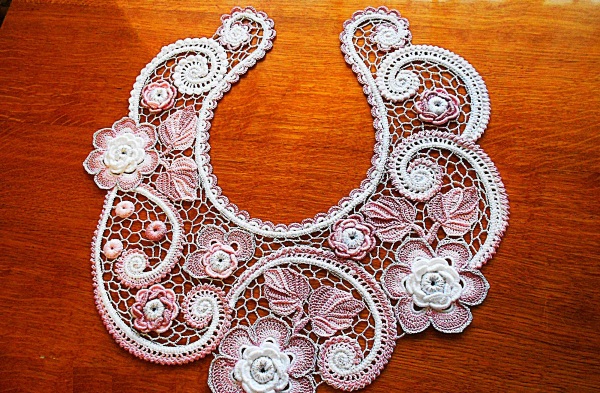
- The piece is turned over, 4 more ch are collected. Everything is knitted, skipping 2 loops of the previous row. The row ends with a combination of 1 ch and 1 dc.
- The product is turned over again, the arches are tied with VP 5 sts without nak. Turn back and knit a row of sts without nak.
- Next comes a row of single crochet stitches, the hook is inserted into the back pp of the previous row.
- Then - a row of st. without yarn over, the hook enters the free st. of the previous row.
- The detail is completed with a "crayfish step".
- After turning the product over to the front side, additional arches of 4 VP are knitted, and then 6 sts without nak are tied around them.
The openwork element is ready.
Irish Lace Style Items
Irish lace originated in 1845, during the so-called "potato famine." At that time, peasants had no choice but to eat potatoes. When the crops were infected with fungus, there was no food left at all.
To earn money for food, they had to learn new crafts. Traditional crafts, such as embroidery, took a lot of time, and the money was needed now.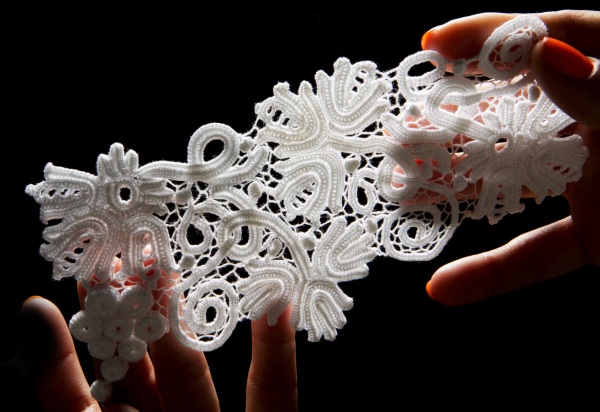
A new type of needlework was proposed by Riego de Blancardier, who came from a noble family. Using a hook, she imitated the lace "Rosalina". While the classic version with a needle required up to 200 hours of work, crocheting took only 20.
In 1846, Riego de Blancardier published a book describing the techniques of weaving this lace. Absolutely everyone, both children and adults, learned this new craft. Weaving techniques allowed things to be knitted together: one knits leaves, another flowers, and so on. Only then were the items woven together by the family using a net.
Today, Irish lace can be used to create various products: napkins, tablecloths, dresses, cardigans and much more.
| Product name | Hook size | Amount of yarn (approximately) |
| Napkin | 1.5 | Depends on the desired size of the napkin (approximately 200 g of cotton thread). |
| Beret | 1.0 | 50 g of yarn. |
| Summer sweater | 1.5-0.5 | For size 49-50 – 150 g (in fragments), you can use a ready-made net. |
| Jacket | 2, and also needle #3 | For size 44 – 750 g of yarn. |
| Collar | 0.6-0.5 | Depending on the desired collar width and neck type of the garment. |
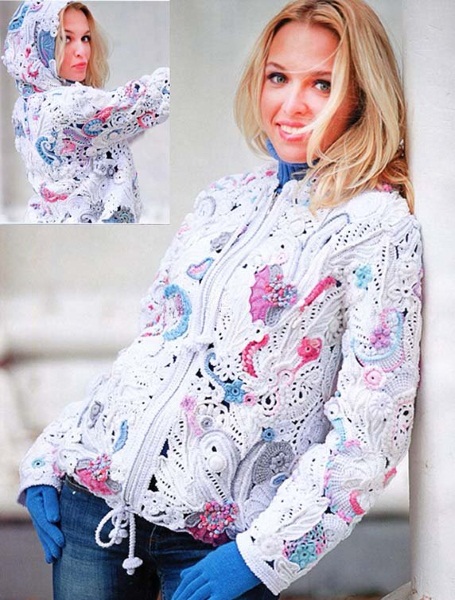
It is worth noting that the hook can be changed depending on the thickness of the yarn.
With the help of a hook and yarn, you can create a unique thing. However, it is worth remembering that Irish lace may not always work the first time. Easy patterns of motifs with descriptions and practice will help a beginner become better at this craft.
Article formatting: Vladimir the Great
Video about Irish lace
Irish Lace for Beginners:
